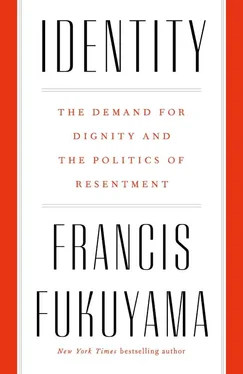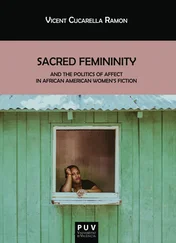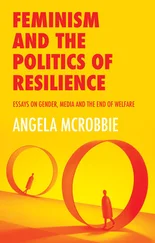The most dangerous of these new right-wing identities are those related to race. President Trump has been careful not to articulate overtly racist views. But he has happily accepted support from individuals and groups that hold them. As a candidate he was evasive in criticizing the former Ku Klux Klan leader David Duke and, after the August 2017 “Unite the Right” gathering in Charlottesville, Virginia, laid blame for the violence on “both sides.” He has spent a lot of time singling out black athletes and celebrities for criticism. The country has become further polarized over whether to remove statues honoring Confederate heroes, an issue Trump has been happy to exploit. Since his rise, white nationalism has moved from a fringe movement to something much more mainstream in American politics. Its proponents argue that it has been politically acceptable to talk about Black Lives Matter or gay rights or Latino voters as groups that can legitimately organize around a specific identity. But if one even uses the adjective white as self-identification or, worse yet, organizes politically around the theme of “white rights,” one is immediately identified, the white nationalists note, as a racist and bigot.
Similar things are happening in other liberal democracies. White nationalism has a long history in Europe, where it was called fascism. Fascism was defeated militarily in 1945 and has been carefully suppressed ever since. But recent events have loosened some of the restraints. As a result of the refugee crisis of the mid-2010s, a panic has arisen in Eastern Europe over the possibility that Muslim migrants might shift the region’s demographic balance. In November 2017, on the anniversary of Poland’s independence, an estimated sixty thousand people marched through Warsaw chanting “Pure Poland, white Poland” and “Refugees get out!” (This was despite Poland’s being home to a relatively small number of refugees.) The ruling populist Law and Justice Party distanced itself from the demonstrators, but, like Donald Trump, sent mixed signals that suggested it was not entirely unsympathetic to the aims of the marchers. {16} 16 Matthew Taylor, “‘White Europe’: 60,000 Nationalists March on Poland’s Independence Day,” Guardian , November 12, 2017; Anne Applebaum, “Why Neo-Fascists Are Making a Shocking Surge in Poland,” Washington Post , November 13, 2017.
The proponents of identity politics on the left would argue that assertions of identity on the right are illegitimate and cannot be placed on the same moral plane as those of minorities, women, and other marginalized groups. Rather, they reflect the perspectives of a dominant mainstream culture that has been historically privileged and continues to be so.
These arguments have obvious truth. Perceptions on the part of conservatives of advantages being unfairly given to minorities, women, or refugees are greatly exaggerated, as is the sense that political correctness has run amok everywhere. Social media contributes heavily to this problem, since a single comment or incident can ricochet around the internet and become emblematic of an entire category of people. The reality for many marginalized groups continues as before: African-Americans continue to be objects of police violence, and women continue to be assaulted and harassed.
What is notable, however, is how the right has adopted the language and framing of identity from the left: the idea that my particular group is being victimized, that its situation and sufferings are invisible to the rest of society, and that the whole of the social and political structure responsible for this situation (read: the media and political elites) needs to be smashed. Identity politics is the lens through which most social issues are now seen across the ideological spectrum.
Liberal democracies have good reasons not to organize themselves around a series of ever-proliferating identity groups inaccessible to outsiders. The dynamic of identity politics is to stimulate more of the same, as identity groups begin to see one another as threats. Unlike fights over economic resources, identity claims are usually nonnegotiable: rights to social recognition based on race, ethnicity, or gender are based on fixed biological characteristics and cannot be traded for other goods or abridged in any way.
Despite the beliefs of certain advocates on both the left and the right, identities are not biologically determined; while they are shaped by experience and environment, they can be defined in terms that are either tightly focused or broad. That I am born a certain way does not mean I have to think in a certain way; lived experience can eventually be translated into shared experience. Societies need to protect the marginalized and excluded, but they also need to achieve common goals via deliberation and consensus. The shift in agendas of both left and right toward the protection of ever narrower group identities ultimately threatens the possibility of communication and collective action. The remedy for this is not to abandon the idea of identity, which is too much a part of the way that modern people think about themselves and their surrounding societies. The remedy is to define larger and more integrative national identities that take account of the de facto diversity of existing liberal democratic societies. This will be the subject of the two following chapters.
In the wake of the 2011 Arab Spring, Syria descended into a devastating civil war that has left an estimated 400,000 people dead. According to the UN High Commissioner for Refugees, 4.8 million people have fled the country, including 1 million going to Europe, and another 6.6 million have been displaced within Syria—this in a country that had a population of 18 million at the start of the conflict. The knock-on consequences of this war include destabilization of the politics of Syria’s neighbors Turkey, Jordan, Lebanon, and Iraq, and a migrant crisis that has rocked the European Union.
Syria is an extreme example of what happens when a country lacks a clear sense of national identity. The proximate cause of the war were peaceful protests that broke out in 2011 against the regime of Bashar al-Assad, which were triggered by the Arab Spring. Rather than stepping down, Assad met his opponents with fierce repression. The latter then responded with violence themselves, and the conflict began to attract the attention of outside groups, with foreign fighters streaming in to join ISIS. The civil war was further deepened by support from Turkey, Saudi Arabia, Iran, Russia, and the United States.
Underlying these events were the realities of sectarian division. Following a coup in 1970, Syria was ruled by Hafiz al-Assad and, after 2000, by his son Bashar, who were members of the Alawite sect. The Alawites, a branch of Shia Islam, constituted perhaps 12 percent of Syria’s prewar population; the majority of the remainder were Sunni Muslims, with significant Christian, Yazidi, and other minority populations. There were also ethnic and linguistic divisions between Arabs, Kurds, Druze, Turkmen, Palestinians, Circassians, and the like, which sometimes also corresponded to religious fractures. Ideological divisions also existed between violent extremists, moderate Islamists, leftists, and liberals. The Alawites had come to dominate Syrian political life because they had been recruited into the military by the French under a divide-and-rule strategy when the latter were the region’s colonial masters. Throughout the Assad family’s rule, the Alawites were hated and resisted by other groups in the country, and stability was maintained only by harsh repression by both Hafiz and Bashar Assad. Little sense of loyalty to an entity called Syria transcended loyalties to one’s sect, ethnic group, or religion, and when the repressive state looked as if it was weakening, as in 2011, the country fell apart.
Читать дальше












